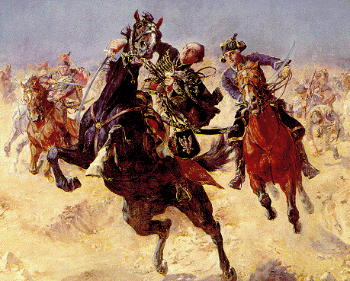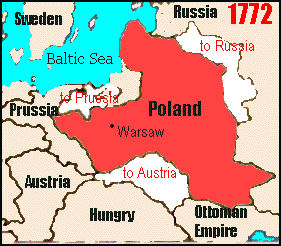Bar Confederation Forms- 1768-1772
After Russia became so involved in Poland-Lithuania, an anti-Russian confederation formed, and in February 1768 the anti-royalists and anti-Russians joined into one group. They became known as the Bar Confederation, which lasted for four years.
 |
Both the anti-royalists and the anti-Russians blamed Stanislaus August for the domination of Poland by Russia: his reform attempts had brought in more Russian troops, and Russia was allowed to stay, they felt, because Stanislaus was capitulating to his ex-lover Catherine the Great. Both confederations wanted to defend the Catholic faith, the golden freedom of the nobility, and Poland-Lithuania’s independence. The Bar Confederation assumed all of these goals, and was headed by the Pulaski family.
The Bar Confederation was centered in southern Poland-Lithuania. The Pulaskis, a strong noble family in the province Wineria, recruited other nobles and peasants willing to fight, and the 6,000 men met at Bar in a deserted fort to design their strategy. They had two mottos: “For the Faith and Liberty” and “To Conquer or to Die.” They led small guerilla bands throughout the countryside, harassing Russian regiments and gathering ammunition. The army was headed by Josef Pulaski and his three sons: Francis, Casimir, and Antoni.
1768 (April 20-April 29)
First Battle. Russian troops were sent into the south to quell the guerilla bands. Casimir Pulaski, nineteen years old and leading a band of the confederation, encountered a larger Russian military detachment of Cossacks. The Bar Confederation used the element of surprise to attack the superior troop and send them into retreat.
However, the Russians returned and sieged the Confederates at a nearby town. The Confederation soldiers had fortified the town with cannons and torn down all the bridges; the Russians could not break through, after an eight hour siege.
 |
When the Confederation tried to move onto the next stronghold, however, the Russians pursued them and backed them into a swamp. The Confederation suffered heavy losses and Casimir himself was nearly killed. However, the Confederation built a road through the swamp to escape. A second group of Confederation soldiers led by Antoni Pulaski arrived to help, but they were slaughtered by the Cossacks. Over 1,000 Polish soldiers were killed.
Despite the heavy loss of men, the first battle was a victory for the Confederation in that it was the first open rebellion in the country. Other nobles, disgruntled by the Russian influence, joined the fight.
1768 (May 28-June 13)
Battle of Berdichev; Casimir Pulaski Captured. Casimir Pulaski and around 1,500 of his men took a monastery in Berdyczow, in western Poland on May 28. Superior Russian forces sieged the monastery for two weeks, cutting off the water supply. Munitions ran short in the fortress, and Poles resorted to stuffing their cannons with glass and stones. Finally, on June 13, Pulaski and his men surrendered, under the condition that no one was to be tortured.
 |
Stanislaus August got the men released from their Russia prison, except for Casimir Pulaski; the Russians felt it was too dangerous to release him. However, the Russians could also not execute him; he was too popular with the peasants and his execution could cause further uprisings. Finally, Casimir was released after he signed an oath vowing to never fight against the king or tsar again–an oath he would not keep–and he was exiled to Turkey.
1768
Raids Launched from Turkey. The Bar Confederation launched raids into Poland from Turkey, using guerilla tactics to hit Russian regiments and take supplies. Josef Pulaski was attempting to pressure Turkey into war with Russia, to help the Bar Confederation; he was instead imprisoned by the Kahn of Turkey, where he died from the plague a few months later. His sons were left to carry on.
1770 (January 3-January 9)
Battle of Bright Hill. The nobles who joined the Pulaskis in their fight decided that they needed to draw the Russians into another open battle, to inspire more nationalism. They picked a site of historical importance to Poland, that of Bright Hill in Czesrochova. It had been the rallying point during the Swedish deluge in 1655, and still connoted Polish pride to the citizens.
 |
(by Henryk Rodakowski, 1875)
So Casimir Pulaski fortified 1,500 soldiers at the monastery of Bright Hill late in 1769. They brought in supplies, made cannon balls from church spires, and covered the monastery roofs with manure, which froze in the winter weather and hardened to protect the roofs from Russian artillery.
In early 1770, 3,500 Russian soldiers sieged Bright Hill. However, the monastery was just as fortified as the Swedes had found it; because of the terrain, the artillery could not be positioned for affective fire. Casimir led raiding parties into the Russian line during respites in the siege, which made his army appear larger than it was.
Because of the triumphant holding of Bright Hill, more nobles to the south roused their own forces and marched on Krakow. The Russians sieging Bright Hill withdrew to go south and protect the capital. Bright Hill was again the site of a major Polish victory.
1771
 |
Attempted Kidnapping. The Bar Confederation attempted to kidnap Stanislaus August to depose him, but they failed. The plot only discredited them in the eyes of other nations, as being rebels and thugs, not freedom-fighters.
1772 (August)
Bar Confederation Ends. Without the hope of foreign assistance, the Bar Confederation began to see their situation as more hopeless. After four years of fighting, Russia and Stanislaus August finally suppressed the confederation. Five thousand Poles were deported to Siberia (Casimir Pulaski managed to escape to Prussia before arrest).
Frederick II of Prussia suggested that to quell future uprisings that Poland-Lithuania should be made smaller; Catherine the Great agreed.
1772
The First Partition. The Treaty of Partition was signed in St. Petersburg in 1772. Austria, Prussia, and Russia signed it, taking away 30% of Poland-Lithuania and 35% of their population.
Russia had long had its eye on controlling Poland-Lithuania and no original intention of giving any land to other countries. Prussia, however, had been allied to Russia, and Frederick II warned Catherine the Great that taking too much land would drive the Hapsburgs and the French into war with them. France and Austria were wary of Russia’s growing power, but Frederick II, always the crafty politician, exaggerated their war preparations to Catherine.
 |
Thus, Austria received a portion of Poland-Lithuania to assuage their fears, and Prussia received territory for their “loyalty.”
The Sejm ratified the partition in 1772; the nobles for the most part had been bribed by the other countries and were willing, as they had proven again and again, to sell out Poland-Lithuania for personal gain.
A few nobles, such as Tadeusz Rejtan from Lithuania, tried to stop the ratification of the Treaty of Partition, but they were grossly outnumbered. [Rejtan would not have to live to see his country further partitioned away; he committed suicide in 1779].
Stanislaus August also fought the partition. He asked for support from Great Britain to begin a war to defend his country. When the help did not come, however, he also gave in.
Russia took 12% with 1 million inhabitants; Austria took 12% as well, taking the more developed southern region with 2 million inhabitants; and Prussia took 5%, taking the most wealthy region, Royal Prussia that bordered the Baltic Sea, with 1/2 million inhabitants.

 Frederick II of Prussia Frederick II of Prussia | The First Partition of Poland  |
Poland-Lithuania was still a large territory, as large as France, but it was cut off from the Baltic Sea and had to continue to factor Russia into their political decisions.Stanislaus August tried to make new reforms, but this time more cautiously, trying to appease both conservatives and the Russians.
1773
First Ministry of Education in Europe. As part of his reforms, Stanislaus set up the first Ministry of Education in all of Europe in 1773. It oversaw a national education system. This brought about an enlightened generation, well-educated and groomed at universities; many were enthralled with the politics of the American Revolution with problems similar to that of Poland-Lithuania. Theater flourished, as did poetry and the printing of books.
Administration also improved under Stanislaus August.
However, he was seen as a puppet king and Poland-Lithuanian remained politically weak and under Russian control. So subdued was the country that most of the Russian troops had been recalled by 1780.
